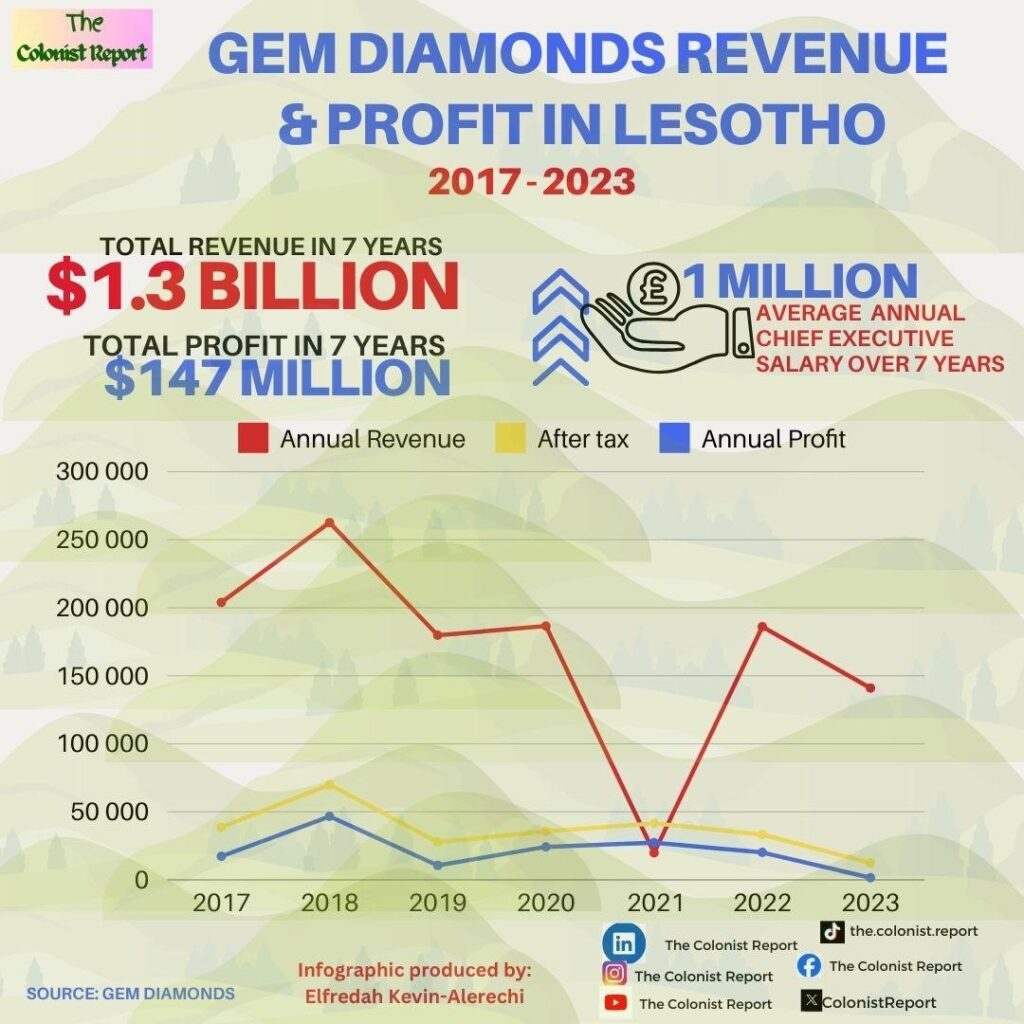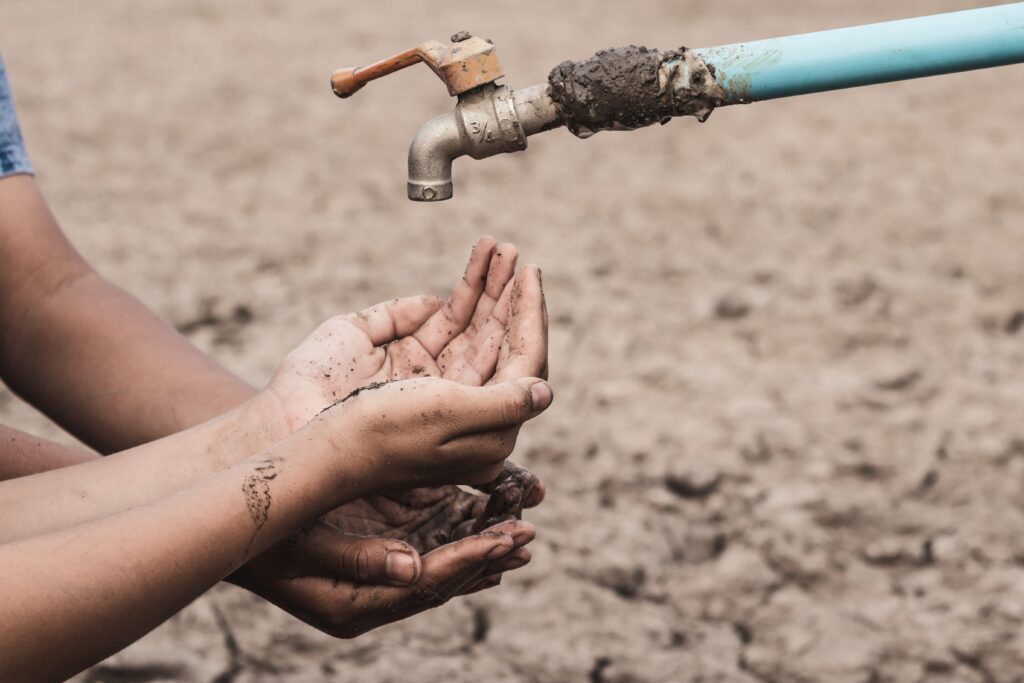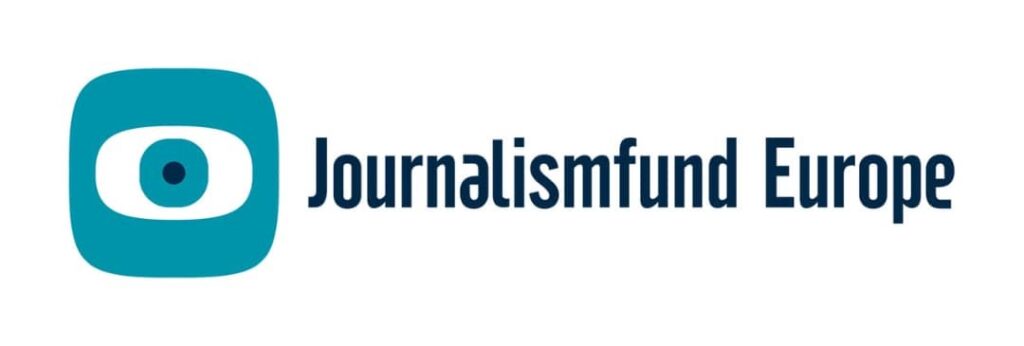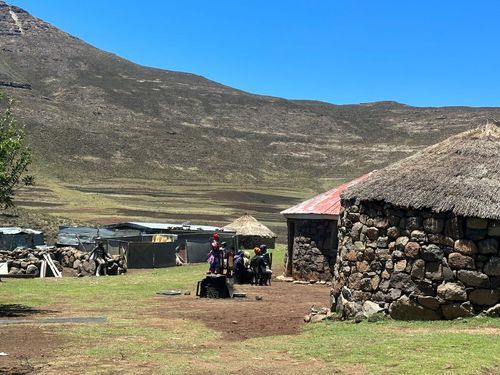By Cindy Sipula, Sechaba Mokhethi and Elfredah Kevin – Alerechi
Part Two
Company’s Comments
Gem Diamond denied that the dust from its mining operations affects the local community. In an email, the company told the Rural Explorer that Letšeng Diamonds has a dust monitoring protocol in place, and the testing of the dust by an eternal laboratory has not shown any negative impact.
The company denied that it has spoiled the community’s water but has helped the community by providing water.
In an email, Mark Antelme, company media officer, stated that the company is very concerned about the environment in its communities and has taken steps to reduce the impact of its activities.
Antelme said: “We are aware of higher levels of nitrates that leach off our waste rock dumps and to a lesser extent, our coarse tailings dumps, and have put the following in place to reduce nitrate levels before leaving the mine lease area and minimise the impact of this on the environment.
“We have retention dams and a wetland that respectively trap and dilute the water leaching from these areas. To minimise the potential for nitrates leaving the mine lease boundary, water in these dams is either reprocessed through our ore treatment plants or treated through our newly constructed bioremediation plant.
“We provide potable water for our communities where we believe water is contaminated with E.coli or other bacteria (this is not caused by the mine, see below) or may contain higher levels of nitrates (i.e. boreholes, spring water standpipes to access points, water tanks, etc.).
“We have recently completed the commissioning of a bioremediation plant to significantly reduce the nitrate levels of water leaching off the active waste rock dump, which we capture in a retention dam.”
According to Antelme, seepage from the dam is trapped in a second pond to be pumped back to the retention dam and treated through the bioremediation plant. Initial results of denitrification are very positive and all water leaching from the dumps will be treated to environmentally acceptable standards before leaving the mine lease area.
The company said it is aware of elevated levels of nitrates in the stream flowing from the active waste rock dump. “We are positive the above actions will reduce this considerably, and regarding the Khubelu River.” The most recent independent water quality assessment, conducted by an accredited laboratory in South Africa, confirmed that nitrate levels in the Khubelu surface water sources at the downstream communities of Patising (23km away from the Letšeng mine) and Maloraneng (20km away from the Letšeng mine) have consistently been within the potable water standards.
However, a previously confidential report by MNN Lesotho has shown the company admitted to contaminating these water sources.
Company’s Awards and profits
Gem Diamonds won the ESG Award for Best Climate-Related Reporting in 2022, and in 2023, the company won the Junior ESG Awards 2023 for Water by Investing in African Mining INDABA, which was chosen by the Mining Indaba Sustainable Committee.
According to the company, the award was given to Gem Diamonds in recognition of its commitment to improving local communities’ access to clean water, as well as its innovative and effective water pollution prevention systems.
The government of Lesotho owns 30 per cent of the Letšeng Diamonds Mine, while Gem Diamonds Limited purchased the mine in July 2006 and now owns 70 per cent of its shares. Gem Diamonds reportedly paid $118.5 million for the company after De Beers operated the mine from 1977 to 1982.
Gem Diamonds made money from its activities in the countries where it operates, including Lesotho. The company’s full-year revenue for 2023 is US$140.3 million, with a profit of US$1.6 million, compared to revenue of US$188.9 million in 2022, with a profit of US$20.2 million.

GEM-Diamonds made the most profit from the Letšeng Diamond Mine with revenue totaling $1.3 billion from 2017 to 2023 and a total profit of $259 million between 2017 and 2023.
On February 17, 2024, the company announced the recovery of a high quality, 113ct Type II white diamond from its Letšeng Diamond Mine, Lesotho—this in addition to the 295 carat high-quality Type II white diamond recovered on January 8, 2024, and a 139-carat low-quality Boart diamond recovered in Lesotho on January 17, 2024, according to the information listed on the London exchange market.
The Letšeng mine produces high-quality gem diamonds, consistently achieving the highest price per carat of any kimberlite mine in the world, according to the company. Since 2006, Gem Diamonds has produced three of the 20 largest white diamonds ever recorded.
Corporate Social Responsibility
Gem Diamonds, in its 2023 annual report, mentioned that it builds schools and offers bursaries for community residents.
Moahi, the community chief, said: aside from taps, the mine has built a footbridge across Khubelu village at Moeaneng Ha ‘Mapoka, allowing children from Lichecheng, Moeaneng, and Patising villages to cross to Ramosoeu Primary School in Matlakeng village.
He said the company has built a community lodge, Maloraneng Lodge, which is now rented out to a tenant who is supposed to pay M30,000 per month, according to their agreement. A field belonging to a late village member was appropriated for the lodge’s construction, and the company built a two-room house in exchange for her land.
Two classrooms were also constructed at Pae-la-Itlhatsoa `Primary School. The company also provided the villagers with food stuffs at the height of Covid-19 pandemic. Pit latrine toilets were constructed at Ha Moroka of Ha Seema, two at the clinic and another 2 at the lodge last year. “But they could not last due to their poor quality and most of them are no longer functional at Maloraneng,” said Moahi.
According to him, there are no schools in the village; “our kids must walk over 30 minutes to get to the nearest school in Pae-la-itlhatsoa.
“We also have a clinic in this village, but it is not reliable; it opens once a month and comes with a salary at the end of every month. Initially, it was only for women and young children, but it has changed to cover everyone, he said, and continued: “They do not have operating hours; they leave once the queue is finished. My village is made up of 80 households.
However, journalists visited the villages in October 2023, the tap water provided by the company was not functioning.

Rights Groups Intervene
Transformation Resource Centre (TRC), a human rights NGO that has intervened between the company and the villagers, says it is unable to address water pollution-related issues because every time they [NGO] meet the community with the Gem Diamonds subsidiary, the company says “it cannot discuss water issues as it claims they are in court and sub judice.
Rokoe Lefera, the special projects officer of the NGO told The Rural Explorer that her organisation attempted to resolve the water pollution problem, but the company countered by saying that they had hired independent, accredited experts to test the water, and the results showed that it was safe for the host communities to drink.
Lefera said the villagers maintained that the water made them sick and even claimed that it had a discoloured appearance. “Afterwards, we reached an agreement to collaborate with the company and the community to engage an impartial specialist—not Letšeng alone—to verify these claims through testing.”
She says regrettably, a faction within the community decided to pursue legal action, prompting them to suspend their plans to refrain from interfering in matters that are under litigation.
Lefera claims Letšeng is avoiding discussing issues related to water, considering the case is in court. “Even when we go to the gatherings, the mine always makes it a point that they can discuss everything except water.”
Lefera noted that TRC is not confined to water-related issues, but is focused on service delivery in general. “We want the host communities to develop. Our focus is on corporate social responsibility; theirs is so broad, and we want something crafted specifically for Pae-
la-Itlhatsoa (the host community) as the most affected. These are the things that we are more interested in.”
Thabo Lerotholi, president of the Maluti Community Development Forum (MCDF), an interest group that advocates for the rights of poor communities in mining areas, is assisting communities affected by Gem diamond mining operations in obtaining justice from the High Court. The organisation is demanding that the court order the company to relocate the villagers.
The reason for seeking a court order to compel the company to relocate villagers is fear of being engulfed by flooding from the mine’s slime dams, as well as possible contamination of the water on which they rely for drinking and other domestic purposes.
Steve Emerman, an MCDF network consultant based in the United States, has offered to conduct the safety audit to assist the High Court in making an informed decision. Emerman owns Malach Consulting, which focuses on groundwater and mining issues. However, Advocate Lerotholi claims that due to their poverty, the community cannot afford to bring Emerman to Lesotho.
“Without actual engineering reports such as dam safety audits, there is no way the court can be in a position to determine the safety or otherwise of the dam,” Emerman said in his confirmatory affidavit.
Lerotholi told The Rural Explorer that its team is considering withdrawing the case from Lesotho court and pushing it to a UK-based law firm.
Laboratory Comments On E.Coli
In an email, the Test It Lab says the water is unsafe for human consumption according to the guidelines set forth in SANS 241, which delineates the minimum standards for water to be considered safe for human consumption.
“When turbidity levels exceed 5 Nephelometric Turbidity Units (NTU), it signifies an operational failure, indicating that the water treatment process is not performing optimally. Moreover, a turbidity level above 1 NTU is considered an aesthetic failure, impacting the water’s appearance and acceptability to consumers”.
“Total coliform counts exceeding 10 Colony Forming Units (CFU) per 100 milliliters are indicative of an operational failure due to an inadequate disinfection process. This suggests that the measures in place to eliminate harmful microorganisms are not sufficiently effective.
“The presence of E. coli bacteria in water is considered a severe health hazard, indicating immediate risk. Consumption of such water should be avoided unless steps are taken to eliminate these bacteria, which may include methods like boiling, chlorination, or other forms of disinfection to ensure safety.
“Nitrates levels surpassing 11 milligrams per litre (mg/L) present a specific risk to pregnant women and certain animal species. Nitrates can bind to haemoglobin in red blood cells,
inhibiting oxygen transport, a condition commonly referred to as “blue baby syndrome” in infants. This condition can also lead to spontaneous abortions in animals due to hypoxia.”
This article is published with support from Journalismfund Europe

Discover more from MAKANDAY
Subscribe to get the latest posts sent to your email.



